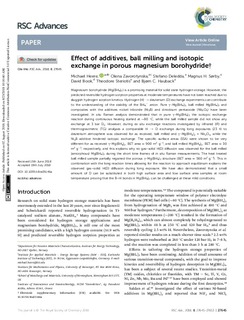| dc.contributor.author | Heere, Michael | |
| dc.contributor.author | Zavorotynska, Olena | |
| dc.contributor.author | Deledda, Stefano | |
| dc.contributor.author | Sørby, Magnus Helgerud | |
| dc.contributor.author | Book, David | |
| dc.contributor.author | Steriotis, Theodore | |
| dc.contributor.author | Hauback, Bjørn | |
| dc.date.accessioned | 2018-08-24T08:57:04Z | |
| dc.date.available | 2018-08-24T08:57:04Z | |
| dc.date.created | 2018-08-23T11:09:15Z | |
| dc.date.issued | 2018-08 | |
| dc.identifier.citation | Heere, M. et al. (2018) Effect of additives, ball milling and isotopic exchange in porous magnesium borohydride. RSC Advances. 8 (49), pp. 27645-27653. | nb_NO |
| dc.identifier.issn | 2046-2069 | |
| dc.identifier.uri | http://hdl.handle.net/11250/2559183 | |
| dc.description.abstract | Magnesium borohydride (Mg(BH4)2) is a promising material for solid state hydrogen storage. However, the predicted reversible hydrogen sorption properties at moderate temperatures have not been reached due to sluggish hydrogen sorption kinetics. Hydrogen (H) → deuterium (D) exchange experiments can contribute to the understanding of the stability of the BH4− anion. Pure γ-Mg(BH4)2, ball milled Mg(BH4)2 and composites with the additives nickel triboride (Ni3B) and diniobium pentaoxide (Nb2O5) have been investigated. In situ Raman analysis demonstrated that in pure γ-Mg(BH4)2 the isotopic exchange reaction during continuous heating started at ∼80 °C, while the ball milled sample did not show any exchange at 3 bar D2. However, during ex situ exchange reactions investigated by infrared (IR) and thermogravimetric (TG) analyses a comparable H → D exchange during long exposures (23 h) to deuterium atmosphere was observed for as received, ball milled and γ-Mg(BH4)2 + Nb2O5, while the Ni3B additive hindered isotopic exchange. The specific surface areas (SSA) were shown to be very different for as received γ-Mg(BH4)2, BET area = 900 m2 g−1, and ball milled Mg(BH4)2, BET area = 30 m2 g−1, respectively, and this explains why no gas–solid H(D) diffusion was observed for the ball milled (amorphous) Mg(BH4)2 during the short time frames of in situ Raman measurements. The heat treated ball milled sample partially regained the porous γ-Mg(BH4)2 structure (BET area = 560 m2 g−1). This in combination with the long reaction times allowing for the reaction to approach equilibrium explains the observed gas–solid H(D) diffusion during long exposure. We have also demonstrated that a small amount of D can be substituted in both high surface area and low surface area samples at room temperature proving that the B–H bonds in Mg(BH4)2 can be challenged at these mild conditions. | nb_NO |
| dc.language.iso | eng | nb_NO |
| dc.publisher | The Royal Society of Chemistry | nb_NO |
| dc.rights | Attribution-NonCommercial-NoDerivatives 4.0 Internasjonal | * |
| dc.rights.uri | http://creativecommons.org/licenses/by-nc-nd/4.0/deed.no | * |
| dc.subject | kjemi | nb_NO |
| dc.title | Effect of additives, ball milling and isotopic exchange in porous magnesium borohydride | nb_NO |
| dc.type | Journal article | nb_NO |
| dc.type | Peer reviewed | nb_NO |
| dc.description.version | publishedVersion | nb_NO |
| dc.rights.holder | © The Royal Society of Chemistry | nb_NO |
| dc.subject.nsi | VDP::Mathematics and natural science: 400::Chemistry: 440 | nb_NO |
| dc.source.pagenumber | 27645-27653 | nb_NO |
| dc.source.volume | 8 | nb_NO |
| dc.source.journal | RSC Advances | nb_NO |
| dc.source.issue | 49 | nb_NO |
| dc.identifier.doi | 10.1039/C8RA05146A | |
| dc.identifier.cristin | 1603959 | |
| dc.relation.project | EC/FP7/607040 | nb_NO |
| cristin.unitcode | 217,8,2,0 | |
| cristin.unitname | Institutt for matematikk og fysikk | |
| cristin.ispublished | true | |
| cristin.fulltext | original | |
| cristin.qualitycode | 1 | |

